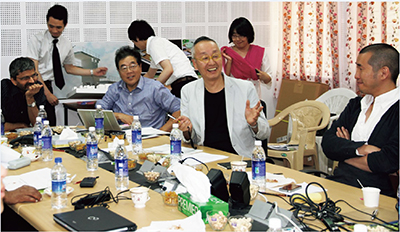Stories from the Field 03
The University of Tokyo Cooperates on the Design of the Indian Institute of Technology Hyderabad (IITH)
– Establishing a Base for the Development of Highly Skilled Human Resources in Science –

A panoramic view of IITH. Among the buildings that the University of Tokyo cooperated in designing, from left: International Guest House, Convention Center, Technology Research Park, Technology Incubation Park, and Knowledge Center (library). (Photo: KAWAZOE Yoshiyuki)

Discussion with the IITH side on site (From right in the photo: Dr. Kawazoe, Dr. Ohno, Dr. Fujino, and then Director of IITH Dr. Desai) (Photo: FUJINO Yozo)
In India, while the labor force is increasing with the population growth, the percentage of people who have received skill training remains at around 10% of the population, causing a shortage of highly skilled human resources required by industry. Human resources development is an urgent issue to promote the manufacturing industry, which requires technological innovation, in order to lead to further job creation. The Government of India provides international-level education and research opportunities through the Indian Institutes of Technology (IITs) founded in 1951, regarding higher education in science and engineering, which is important for developing human resources that support Indian industry. As there was a need for further expansion of the institution in order to meet the human resources needs of the industry, the Government of India requested Japan’s cooperation in establishing a new institution of IITs in Hyderabad (IITH). Following the Japan-India Summit Meeting in October 2008, the two countries agreed to cooperate with the aim of establishing a world-class educational institution that would become a symbol of Japan-India cooperation by introducing Japanese-style management and engineering education to India and strengthening human and academic exchanges between the two countries.
Dr. FUJINO Yozo, Professor of the University of Tokyo at the time and the team leader for the IITH design, looks back and says, “Multiple Japanese universities collaborated in the establishment of IITH. I served as a leader on urban engineering in the working group, which was established in response to a request for cooperation from then Prime Minister Singh of India in 2007, consisting of industry, government, and academia officials from both countries, and led the discussion on how Japan could contribute to the establishment of IITH. The University of Tokyo was highly recognized for its design skills, and was asked to cooperate on the design.” From 2011, Dr. OHNO Hidetoshi, then professor at the University of Tokyo, and Dr. KAWAZOE Yoshiyuki, associate professor at the same university, joined the team, and the University of Tokyo cooperated in designing a total of six buildingsNote 1 that symbolize IITH, including the Technology Incubation Park, Convention Center, and International Guest House.
During the design process, the team held a total of 15 on-site discussions with the Indian side. Dr. Ohno says, “While incorporating Indian culture and design, such as the distinctive roof shape used in traditional architecture in the Bengal region, we also incorporated elements of traditional Japanese patterns and rock gardens. The pond built in front of the International Guest House is inspired by the Indian stepwell remains, and it contributes to the greening of the campus.” Dr. Kawazoe explains, “The University of Tokyo is promoting Japan’s design skill overseas, with its plan to implement the College of Design concept, among others. India stands out in the science field but will benefit from improvements in design skills and quality. I believe that through this cooperation, we were able to convey Japan’s design skills. Furthermore, in the cooperation process, we did not simply hand over drawings, but continued discussions through video conferences and other means even during the spread of COVID-19 to ensure the completion of high-quality construction. This demonstrated the typical Japanese attitude of cooperation that conveyed a commitment to quality, going beyond the entrusted drawings to complete the construction with excellence.”
Dr. Fujino describes future prospects; “The Technology Incubation Park that Japan was involved in designing has led to industry-academia cooperation, with a Japanese company opening a center for joint research with IITH. On the academic side, although IITH does not have a department comparable to the architecture department of Japanese universities, we as architects plan to give lectures locally as a result of our cooperation in the design.” Japan also cooperates with IITH’s human resources development. By 2020, 116 students from IITH had studied at Japanese universities using a scholarship provided by JICA through the project for future researchers at IITH (FRIENDSHIP Project), and some of them have joined the faculty at IITH after obtaining their doctorate in Japan. JICA and the Japan External Trade Organization (JETRO) co-sponsored with IITH a total of six career fairs by Japanese companies by 2023, and exchanges among industrial personnel are becoming more active. It is expected that exchanges between Japan and India based at the Hyderabad campus will thrive.
Note 1: Later, IITH additionally requested the construction of a Technology Research Park with the same design as the Technology Incubation Park, bringing the total number of buildings that Japan has helped design to seven.
<< Previous Page Next Page >>
Main Text | Reference Statistics | Stories from the Field | Master Techniques from Japan to the World | ODA Topics
